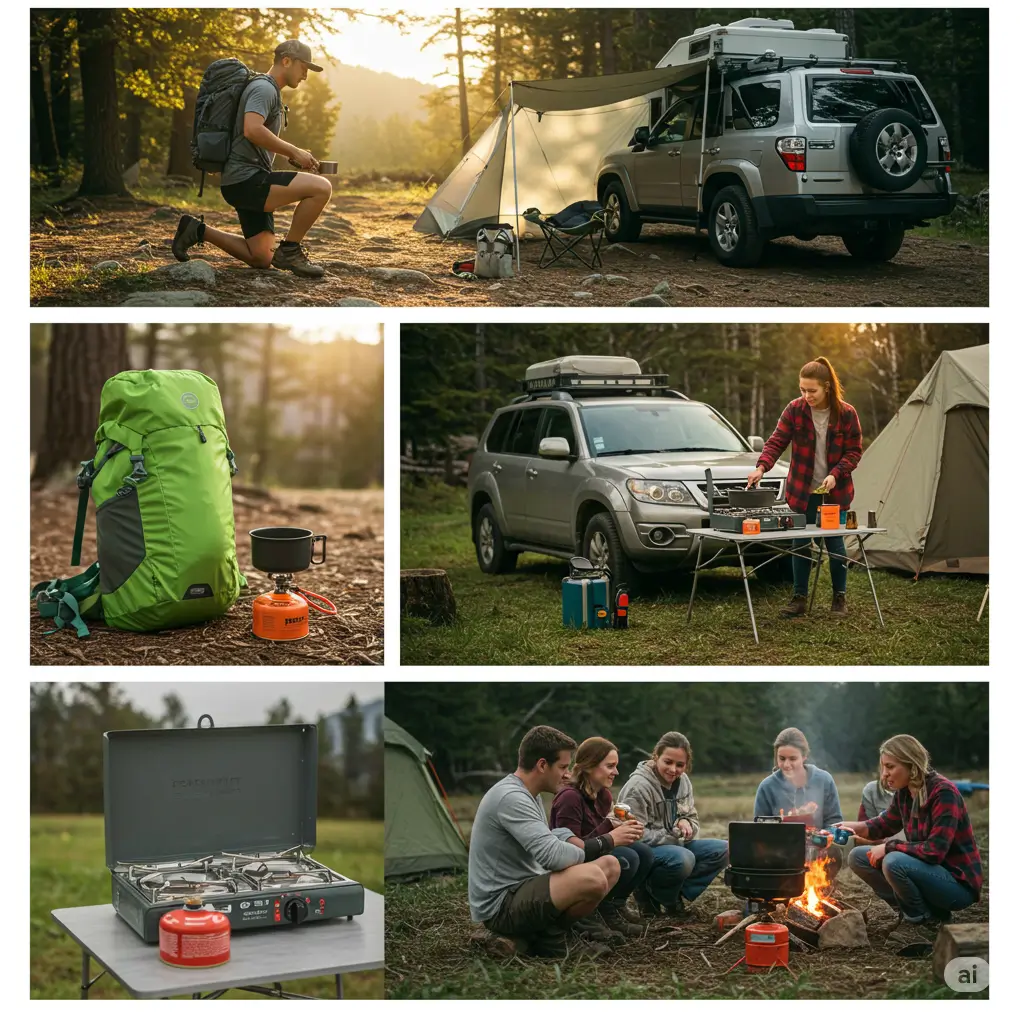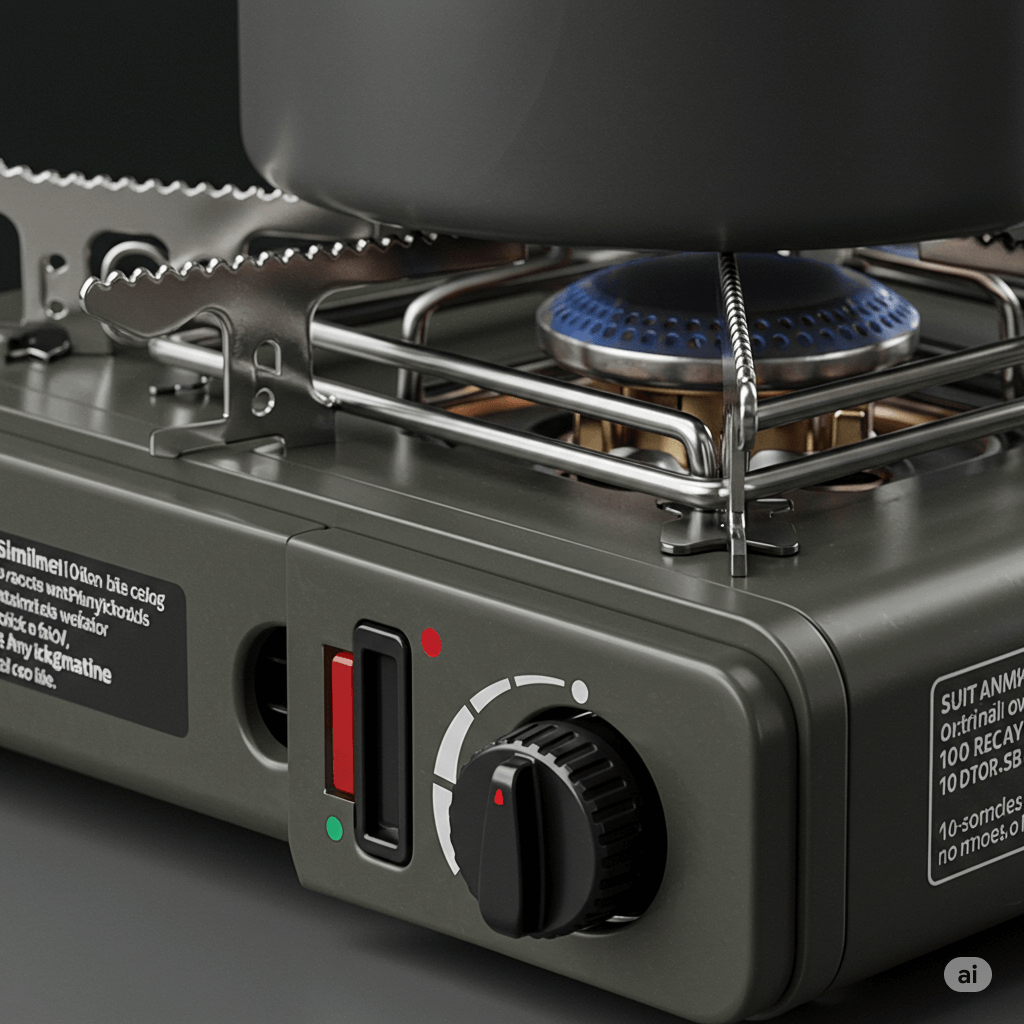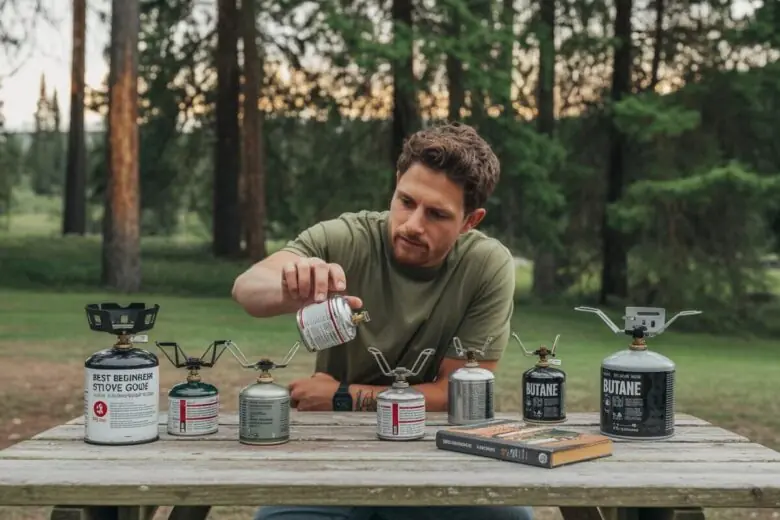Whether you’re planning your first overnight hike or gearing up for a full weekend of car camping, choosing the right gear can make or break your outdoor experience—especially when it comes to cooking. If you’re wondering how to choose a camp stove, you’re not alone. With so many models, fuel types, and features available, it’s easy to feel overwhelmed.
This beginner’s guide to camp stoves will help you cut through the confusion. We’ll break down the different types of stoves, fuel options, and essential features to consider based on your camping style. Whether you’re backpacking solo or cooking for a group, this guide will help you find a stove that’s safe, reliable, and suited to your adventures.
Let’s get started and find the perfect portable camp stove for your next trip.
Understand the Different Types of Camp Stoves
Choosing the right stove starts with understanding the different camping stove types and how each fits your adventure style. Whether you’re car camping on the weekend or heading into the backcountry, selecting the right stove can make cooking easier, faster, and safer—especially for beginners.
Here’s a breakdown of the most common stove types, their advantages, and ideal use cases:
🔥 Canister Stoves: Compact and Beginner-Friendly
Canister stoves are the most popular choice among beginners—and for good reason. These stoves screw directly onto pressurized fuel canisters (usually butane or isobutane-propane mixes), making them incredibly easy to set up and use.
Best For:
-
Beginner camping gear setups
-
Solo backpackers and hikers
-
Lightweight travel in mild to moderate climates
Pros:
-
Fast ignition and heat control
-
No priming or pumping required
-
Compact and lightweight
Cons:
-
Can struggle in cold or high-altitude conditions
-
Limited fuel availability in remote areas
🛢️ Liquid Fuel Stoves: Ideal for Cold and Extended Trips
Liquid fuel stoves use white gas or other liquid fuels stored in refillable bottles. Though slightly more complex, they offer superior performance in freezing temperatures and remote environments.
Best For:
-
Long-distance backpackers
-
Cold-weather camping or mountaineering
-
International travel where fuel types vary
Pros:
-
Works well in extreme cold
-
Fuel is more economical and refillable
-
Great for high-output cooking
Cons:
-
Requires priming and regular maintenance
-
Bulkier and heavier than canister stoves
🌿 Wood-Burning Stoves: Eco-Friendly and Fuel-Independent
For campers who want to go fuel-free, wood-burning stoves are a sustainable and rugged option. These stoves burn twigs, pinecones, and small branches—making them ideal for minimalist or off-grid trips.
Best For:
-
Bushcraft and survival camping
-
Areas with abundant dry wood
-
Eco-conscious campers
Pros:
-
No need to carry fuel
-
Great for long trips where resupply is limited
-
Simple and low-tech
Cons:
-
Dependent on dry weather and available fuel
-
Slower cooking and less flame control
-
Produces smoke and soot
🍶 Alcohol & Solid Fuel Stoves: Ultralight Simplicity
These stoves are favored by ultralight backpackers and thru-hikers for their simplicity and weight savings. Alcohol stoves burn denatured alcohol, while solid fuel stoves use fuel tablets.
Best For:
-
Thru-hikers and solo ultralight campers
-
Emergency kits and backup stoves
-
Minimalist cooking (boil-only setups)
Pros:
-
Incredibly lightweight and silent
-
No moving parts to break
-
Affordable and easy to make DIY versions
Cons:
-
Slower boil times
-
Not ideal for cold or windy conditions
-
Limited cooking control
Understanding these core stove types will help you narrow down your options and choose a stove that fits both your camping needs and experience level. In the next section, we’ll look at how different camp stove fuels affect performance, convenience, and cost.
Compare Camp Stove Fuel Types
Choosing the right camping stove fuel type is just as important as picking the stove itself. Different fuels affect how well your stove performs in various weather conditions, elevations, and regions. Understanding these options helps improve fuel efficiency and ensures camp stove safety, especially in unpredictable environments.
Below is a breakdown of the most common fuel types used in portable camping stoves, including their strengths and limitations.
⛽ Propane & Butane Canisters: Convenient but Sensitive to Cold
Propane and butane are popular choices for canister stoves due to their convenience. They come in pressurized, pre-filled canisters that easily attach to most backpacking stoves. While both are clean-burning and easy to use, they behave differently in cold weather:
-
Propane works better in lower temperatures than butane
-
Butane is more compact and lighter but struggles to vaporize below freezing
Best For:
-
3-season campers
-
Short weekend trips
-
Mild climates
Watch Out For:
-
Poor performance in freezing weather
-
Canisters cannot be refilled (single-use)
❄️ White Gas: Ideal for Winter or High-Altitude Use
White gas, also known as Coleman Fuel, is a liquid fuel ideal for extreme environments. It burns hot and clean, making it the go-to choice for high-altitude adventures and cold-weather camping.
Best For:
-
Mountaineering and alpine expeditions
-
Extended trips with large cooking demands
-
Cold or windy environments
Pros:
-
Excellent in freezing conditions
-
Refillable bottles reduce waste
-
Consistent flame in all conditions
Cons:
-
Requires priming and careful handling
-
Heavier and more complex setup
🔄 Isobutane Mixes: Balanced for Moderate Climates
Isobutane-propane mixes are engineered for improved vapor pressure, offering more consistent performance than regular butane. These blends make a great middle-ground fuel—perfect for spring-to-fall backpacking trips.
Best For:
-
Backpackers in variable climates
-
Users of ultralight or integrated stoves (like Jetboil)
Pros:
-
Stable performance down to moderate cold
-
Compact and efficient fuel usage
-
Widely available in outdoor stores
Cons:
-
Still less effective below 15°F (-9°C)
-
More expensive than plain butane or propane
🌍 Multi-Fuel Options: Great for International Travel
Multi-fuel stoves are highly adaptable and can run on a variety of fuels including white gas, kerosene, unleaded gasoline, and even aviation fuel. This makes them ideal for travelers heading to remote regions where standard fuel canisters may not be available.
Best For:
-
International travel and remote expeditions
-
Long-term backpackers who need flexibility
-
Survivalists or preppers
Pros:
-
Use any fuel available locally
-
Versatile and durable
-
Built for long-term use
Cons:
-
Heavier and more expensive
-
Requires cleaning and maintenance
-
Some fuels burn dirtier than others
Pro Tip: Always match your stove to the fuel type it’s designed for. Using the wrong fuel can damage your stove or create safety hazards. If you’re unsure which stove to choose, check out our detailed guide on The Best Camping Stoves in 2025: Cook Anywhere, Anytime.
Match the Stove to Your Camping Style

When choosing a stove, it’s not just about fuel or design—it’s about how and where you’ll be using it. Whether you’re hiking solo through the mountains or setting up basecamp with friends, the right stove should align with your camping style and cooking needs. Understanding the difference between a backpacking stove vs. camping stove can save you both weight and frustration.
Here’s how to match your stove to your specific camping scenario:
🥾 Backpacking: Prioritize Weight and Size
Backpackers need to think light and pack small. A good backpacking stove should be compact, fuel-efficient, and easy to set up. Canister stoves and alcohol stoves are popular for their minimal bulk and quick boil times.
Recommended Stove Types:
-
Canister stoves
-
Alcohol stoves
-
Ultralight solid fuel options
Why It Works:
-
Reduces overall pack weight
-
Simple, fast setup for on-the-go meals
-
Reliable even on multi-day treks
🚙 Car Camping or Overlanding: Focus on Comfort and Performance
If you’re traveling by vehicle, you can bring along heavier gear without worry. This opens the door to dual-burner propane stoves or larger liquid-fuel models that provide better flame control, multiple cooking surfaces, and higher output.
Recommended Stove Types:
-
Dual-burner propane stoves
-
Liquid fuel stoves (for colder destinations)
-
Tabletop grills or hybrid camp kitchens
Why It Works:
-
Offers more control for gourmet-style meals
-
Easier to cook for multiple people
-
Greater fuel capacity for extended stays
👥 Group Cooking: Go for Multi-Burner Options
Cooking for a crowd? You’ll need a stove that can handle larger pots, multiple dishes, or simultaneous cooking. Multi-burner camp stoves are perfect for families or group trips where shared meals are part of the experience.
Recommended Stove Types:
-
Multi-burner propane stoves
-
Modular stove systems
-
Campfire grates with side burners
Why It Works:
-
Can cook multiple dishes at once
-
Saves time feeding larger groups
-
Sturdy design handles heavy cookware
🏕️ Weekend or Casual Camping: Value Simplicity and Reliability
If you camp a few times a year or enjoy relaxed weekend trips, look for a stove that’s easy to operate and dependable. Canister stoves and portable propane models offer a great balance of ease and performance.
Recommended Stove Types:
-
Canister stoves
-
Single-burner tabletop stoves
-
All-in-one cooking systems (like Jetboil or Camp Chef)
Why It Works:
-
Minimal learning curve
-
Quick meals without setup hassle
-
Easy to clean and pack away
Pro Tip: Think about the type of cooking you’ll be doing—boiling water, simmering meals, or grilling—and match your stove accordingly. Choosing the right setup enhances both safety and enjoyment while cooking while camping.
Key Features to Consider Before Buying

Before investing in a camp stove, it’s essential to know what to look for in a camp stove to ensure it meets your cooking needs and camping style. Understanding core features can save you money and hassle down the line. Whether you want a lightweight camp stove for backpacking or a sturdy burner for car camping, these are the must-have specs and functions to evaluate.
🎛️ Simmer Control and Flame Adjustability
A stove with precise simmer control lets you cook a wider variety of meals beyond just boiling water. Adjustable flames improve fuel efficiency and help avoid scorching delicate foods. This feature is especially valuable for slow cooking or warming sauces.
🔄 Integrated Ignition (Piezo Igniter)
Many modern stoves come with a built-in piezo igniter, which allows you to light the stove without matches or lighters. This feature adds convenience and safety, especially in wet or windy conditions. However, some campers prefer carrying an external fire starter as a backup.
🧱 Stability, Wind Protection & Build Quality
A stove’s stability is crucial to avoid spills and accidents. Look for wide, sturdy pot supports and a solid base. Good windscreens protect the flame from gusts, improving heat retention and fuel efficiency. High-quality materials like stainless steel or aluminum also ensure durability in harsh outdoor conditions.
🪶 Weight and Packability for Travel
For backpackers, every ounce counts. A lightweight camp stove that packs small and fits easily into your gear can make all the difference. Compact folding designs and integrated carrying cases help save space and reduce carry weight, making your outdoor cooking setup more manageable.
Safety, Maintenance, and Accessories for Beginners
Proper safety and maintenance are key to enjoying your camp stove hassle-free and extending its life. For beginners, understanding camp stove safety and regular portable stove maintenance ensures smooth cooking and prevents accidents.
🧯 Camp Stove Safety Tips for New Users
Always inspect your stove before each use. Check the ignition valve for leaks or damage, and never use your stove indoors or inside a tent due to carbon monoxide risks. Use a fireproof mat underneath your stove to protect surfaces and reduce fire hazards. Follow manufacturer instructions closely and never leave a lit stove unattended.
🧰 Basic Maintenance & Storage Guidelines
Keep your stove clean by removing soot and food debris after every trip. Store it in a dry place to prevent rust or corrosion. Regularly inspect seals and fuel lines for wear, and lubricate moving parts if recommended. Proper storage and maintenance boost performance and safety.
🛠️ Spare Parts: O-rings, Fuel Line, Gaskets
Carrying spare O-rings, fuel line replacements, and gaskets is smart, especially on longer trips. These small parts can wear out or get damaged, leading to leaks or stove failure. Many stove brands offer repair kits to keep you cooking no matter what.
🎒 Must-Have Accessories: Mat, Pouch, Cookware
Invest in practical accessories like a heat-resistant fireproof mat, a durable stove pouch for protection and portability, and compatible camp cookware optimized for your stove’s burner size. These extras enhance safety and convenience, making outdoor cooking easier.
Not sure which stove is right for you? Check out our guide to The Best Camping Stoves in 2025 for top-rated recommendations.

